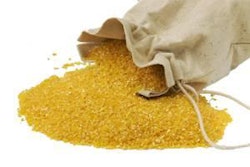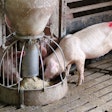As energy costs continue to rise, researchers at Tecaliman, the Nantes, France-based feed technical center, have been experimenting with an acidifying additive that has potential to decrease feed mill energy bills. This method allows feed plants to lower its heat treatment temperature while improving its enterobacteria-fighting efficiency. According to the center, decreasing the feed heat treatment temperature by 5 C can produce 30 percent savings on energy consumption.
The center is exploring how to obtain this temperature decrease without challenging the parameters of feed quality — especially regarding Salmonella and enterobacteria decontaminations. The center’s research on this issue has been funded largely by Agence de l’Environnement et de la Maîtrise de l’Energie (ADEME), the French environment and energy management agency; with additional funding provided by five acidifying additives producers: Altilis Nutrition Animale (Kemira distributor in France); BNA (BASF distributor in France); DSM; Kemin; and Perstorp.
With heat treatment being a tried-and-true method of managing feed safety, the prospect of the cost-saving benefits of acidity additives has revitalized the industry’s interest in the topic.
The known benefits of heat treatment
In 2000, the positive effects of pelletization were demonstrated by the research center in correlation with the European regulation regarding zoonoses. By law, feed manufacturers must decrease the enterobacteria pressure from three logs in compound feed and make sure no Salmonella remains. (EU regulation 2160/2003 and French authorization for a feed plant to produce poultry feed for reproductive farms.)
Steam incorporation is the primary control tool when sterilization is demanded; however, precautions had to be taken during delivery and storage due to recontamination. Accordingly, Tecaliman worked to establish validated thermal process conditions (temperature, schedule and compression) for the main types of feed: pig, hen, broiler, turkey.
Tecaliman’s studies regarding control of microbial contamination are numerous. Controls range from identification of contamination sources in feed mills (e.g. wheat byproducts and meals are more contaminated by enterobacteria than corn) to the study of steam processes, i.e. at the pilot scale level (meals, pellets) and the creation of a qualification method. It created a method allowing for the control of microbiological conditions in feed mills and the analysis of risk control regarding salmonella product contamination, before and after technological processing.
On another field, the center gained a strong understanding of feed mill energy performance through its biannual monitoring of more than 40 plants.
According to Fabrice Putier, Tecaliman’s director, during its last annual symposium: “The role of the feed industry in controlling zoonosis may be dealt with at two levels: delivery in farms and production process. Tecaliman began to work on control tools at the beginning of the 90s, mainly from a Salmonella point of view because of regulation. Monitoring raw material contaminations and HACCP at the mill level drove us to write process recommendations. We’ve worked on heat treatment against Salmonella and, more widely, against enterobacteria — that is how we dealt with optimization of heat treatment temperature with acidifying additives.”
The team shows that acidifying additives have no strong effect directly on enterobacteria even if former studies with propionic acids had shown effect in labs. However, acidifying additives might have a synergetic action with heat treatment. As a result, Tecaliman launched the Syttac program in 2009. Syttac is acronym which, when translated, means: synergy between heat treatment and acidifying additives in feed industry.
Syttac research results
The first step had been to test the use of formic acid, which is often included in the formulation of decontamination products, as a reference and to identify the optimal dosage.
“Recommended doses to control bacteria, around 1.6 percent, are not compatible with materials (because of corrosion) or with animal consumption. A first step gave us the opportunity to make a very positive appraisal of the efficiency of this acidifying additive, but the dose wasn’t compatible with our industry and clients,” summarizes Putier. “We looked for the optimal zone in our pilot installation by slowly increasing the dose and decreasing the temperature of heat treatment at the same time. We’ve tested steam and pelletization on pig and poultry feed as we know that some heat is also generated by friction in pellet dies depending on the formulation.”
Once the synergic effect was demonstrated, the team widened the acidifying-products tests by trying several products at the doses the suppliers established.
The final step: conduct tests in feed plants. Putier says: “We’ve been able to show it is worth presenting the feed industry with this opportunity. The economic interest must take into account the additive price — knowing that 0.4 percent of concentration seems enough — and the energy price. But another important aspect is also to know how acidifying the feed also protect it from recontamination at the farm level.”
To fight enterobacteria, feed manufacturers can use several tools. In addition to quality raw material selection, Putier suggests acidification as a first step, combined with steam treatment for feed presented in meal. For pellets, he says pelletization is the first step and acidification lends a helping hand.
“To choose between several acidifying additives, one will have to test on its own plant and combine with it process parameters” explains Putier. “We don’t want to give any commercial advice about which product to use but we wanted to show that it is possible to do so.”















